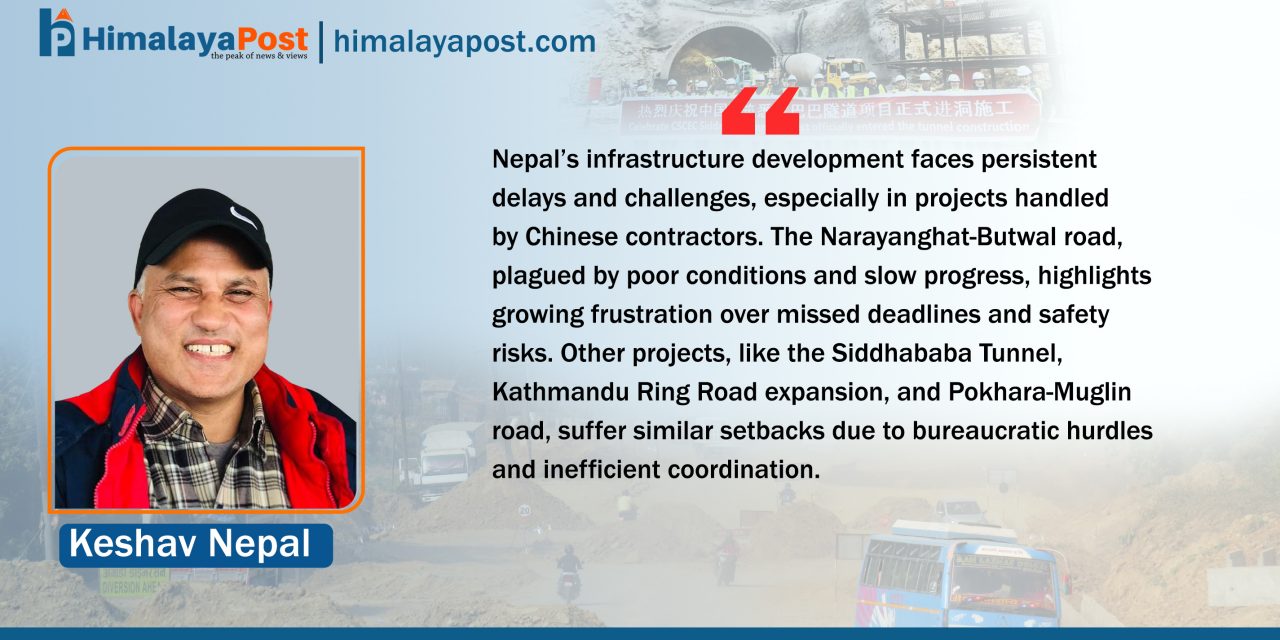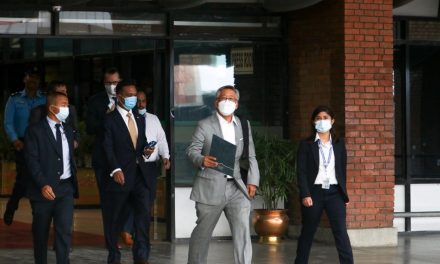– Keshav Nepal
Nepal’s infrastructure development faces persistent delays and challenges, especially in projects handled by Chinese contractors. The Narayanghat-Butwal road, plagued by poor conditions and slow progress, highlights growing frustration over missed deadlines and safety risks. Other projects, like the Siddhababa Tunnel, Kathmandu Ring Road expansion, and Pokhara-Muglin road, suffer similar setbacks due to bureaucratic hurdles and inefficient coordination.
A recent journey to Lumbini revealed the appalling condition of the Narayanghat-Butwal road, sparking widespread frustration toward the contractor responsible for its maintenance and improvement. While occasional travelers are inconvenienced by the road’s poor state, the daily struggles of local residents paint an even grimmer picture. Dust-filled air poses severe health risks, while potholes and scattered construction materials increase the likelihood of accidents. Persistent delays and negligence in completing the project have fueled resentment, particularly against the Chinese contractors managing it.
The Narayanghat-Butwal road expansion project, awarded on 8 Chaitra 2075, was initially set to be completed by 22 Shrawan 2079. However, with the project now on its third extension, questions have arisen about the competence of China State Construction. This project exemplifies a broader issue in Nepal, where Chinese contractors often face criticism for delays and unmet commitments, raising concerns about their efficiency and the Nepalese government’s capacity to oversee these ventures effectively.
Similar challenges plague other infrastructure projects across the country, especially those managed by Chinese state-owned companies. For instance, the Siddhababa Tunnel along the Siddhartha Highway began its contracting process in 2078 BS, but actual construction only started two years later. Although recent progress has been reported, doubts persist about meeting the five-year deadline.
The second phase of Kathmandu’s Ring Road expansion faces comparable setbacks. Despite a government-to-government agreement signed in 2018, the project remains abandoned, severely disrupting daily commutes. The first phase (Koteshwor-Kalanki) took nearly six years to complete by 2075 BS, but bureaucratic hurdles and indecision have stalled progress on the second phase, reflecting inefficiencies in collaboration with the Chinese firm involved.
The Pokhara-Muglin road project is similarly mired in complications. While the western section (Pokhara-Jamune) is managed by Yanhui Kaiyuan Highway and Bridge Construction and the eastern section (Jamune-Muglin) by China Communication Construction, work on both sections has been delayed since construction began in 2078 BS, causing significant hardships for local residents.
Experts attribute these delays to several factors, including lengthy pre-project preparations, inadequate local government support, frequent natural disasters, and bureaucratic red tape. However, there are exceptions. The Pokhara International Airport, built by China CMC Engineering, was completed efficiently, while tunneling for the Sunkoshi Marine Diversion project by China Overseas was finished ahead of schedule.
In contrast, the Rasuwa-Timure dry port project, funded by China, remains incomplete. Despite construction starting on 4 Mangsir 2076 and a targeted completion date of Baisakh 2079, only 65% of the work has been finished. Similarly, the Damak Industrial Park, announced on 16 Falgun 2077 with promises of significant Chinese investment and over 100,000 jobs, has shown little progress.
The Bhotekoshi Hydropower project, a 102 MW initiative in Sindhupalchowk managed by Chilime Hydropower Company and contracted to Guangxi Hydro and Electrical Construction, also lags behind schedule. Originally expected to be completed by 2075 BS, the project remains unfinished.
As Nepal grapples with the complexities of international construction contracts, the need for stronger oversight, improved coordination, and greater accountability has never been more critical. The struggles with Chinese contractors underscore the broader challenges in infrastructure development, urging Nepal to reassess how it can better utilize foreign investment to achieve its development goals.





